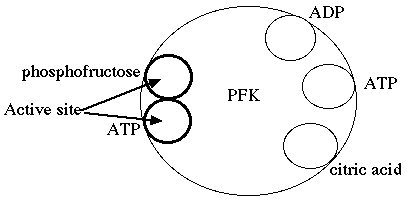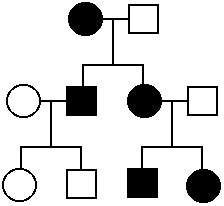10) Draw a cartoon of phosphofructoskinase. Make sure you show all the binding sites for substrates and allosteric modulators. You can make the assumption that each of these binding sites is at a different location on the protein. Label each site.

Fall 1999 Biology 111 Exam #3 - Bioenergetics
There is no time limit on this test, though I have tried to design one that you should be able to complete within 2.5 hours, except for typing. You are not allowed to use your notes, old tests, or any books, nor are you allowed to discuss the test with anyone until all exams are turned in at 11:30 am on Monday November 22. EXAMS ARE DUE AT CLASS TIME ON MONDAY November 22. You may use a calculator and/or ruler. The answers to the questions must be typed on a separate sheet of paper unless the question specifically says to write the answer in the space provided. If you do not write your answers on the appropriate pages, I may not find them unless you have indicated where the answers are.
Please do not write or type your name on any page other than this
cover page. Staple all your pages (INCLUDING THE TEST PAGES)
together when finished with the exam.
Name (please print):
Write out the full pledge and sign:
http://www.davidson.edu/student/redbook/honorgeneral.html#honorcode
"On my honor I have neither given nor received unauthorized information regarding this work, I have followed and will continue to observe all regulations regarding it, and I am unaware of any violation of the Honor Code by others."
How long did this exam take you to complete (excluding typing)?
Lab Questions:
6 pts.
1) Interpret these results as completely as you can. The mutagen
for this experiment was tobacco extract and the numbers came from
this year's results:
|
Salmonella strain |
amount of mutagen (µg/ml) |
number of colonies |
|
1535 |
0 |
18 |
|
1535 |
15 |
57 |
|
1535 |
30 |
115 |
|
1535 |
45 |
182 |
|
1535 |
60 |
43 |
|
102 |
0 |
112 |
|
102 |
15 |
155 |
|
102 |
30 |
166 |
|
102 |
45 |
127 |
|
102 |
60 |
187 |
4 pts.
2) What experiment needs to be done next if a substance (for
example a new food coloring) is shown to be mutagenic in Salmonella?
Explain your answer. You do not have to outline all the steps
in this next experiment, just tell me what type of experiment
would need to be performed and why.
If it mutates bacteria, it needs to be tested
on eukaryotic cells. Therefore, it should be tested on yeast,
or cells grown in culture and eventually animals other than humans.
These tests would need to determine if there are more mutations
(cancers in animals) with the food coloring than without it.
Lecture Questions:
9 pts.
3) a) In general terms, what happens during the light reaction
of photosynthesis? Tell me what is consumed and what is produced.
Light energizes chlorophyll a at the reaction
center and an electron is excited and used to reduce ferredoxin.
This electron is used to produce a hydrogen gradient in the thylakoid
space which is used to generate ATP. Some electrons wind
up going all the way to reduce NADP+ to form NADPH.
Water is split to replace the electrons that leave the
photosystem II in non-cyclic electron flow. H+ and O2 are waste products from the split water.
b) In general terms, what happens during the dark reaction
of photosynthesis? Tell me what is consumed and what is produced.
.The dark reaction takes in CO2 and binds it to (fixes carbon) a 5 carbon sugar
called ribulosebisphosphate. These 6 carbons are energized with
ATP and reduced by NADPH to produce two copies of
a 3 carbon sugar called glyceraldehyde 3-phosphate (G3P).
If this cycle goes around 3 times, 3 carbons are fixed and 6 copies
of G3P are produced. One G3P is new and the other five are energized
with more ATP and rearranged to produce 3 copies of the
starting material, 5 carbon sugar called ribulosebisphosphate.
10 pts.
4) a) List the molecules in a leaf can absorb the energy in
white light.
pigment molecules such as chlorophyll a;
chlorophyll b, and carotenoids.
b) Describe which wavelengths of light are absorbed by each of
your answers in part a.
in the same order: red, blue; red, blue;
not the color of fall leaves since that is what is reflected,
so some don't absorb yellow, others don't absorb red but they
would absorb other colors of light but probably not green.
c) Which of these molecules (from part a) is the last one with
the light energy before the energy is sent on to ferredoxin?
chlorophyll a
6 pts.
5) Explain how oxygen winds up leaving a chloroplast but entering
a mitochondrion. In other words, how can the same molecule (O2) "know" to leave a chloroplast but enter
a mitochondrion?
Oxygen is hydrophobic so it can cross
membranes. Since oxygen is produced as a waste product in the
chloroplast, it diffuses out from the area of higher concentration
to the rest of the leaf which is an area of lower concentration.
Oxygen is consumed in the mitochondria so oxygen diffuses into
this organelle since there is a lower concentration as oxygen
is reduced to water.
9 pts.
6) a) In general terms, how is water consumed during photosynthesis?
Water is consumed by photooxidized chlorophyll
a. The two molecules of chlorophyll a at a reaction center rip
two electons from water.
b) What is produced when water is consumed?
H+ and O2 are waste products from the split water.
c) Where does each product (answers to part b) go once it is produced?
H+ adds
to the proton-motive force and is used to produce ATP. O2 diffuses from the chloroplast (see answer to
#5 above).
6 pts.
7) Describe the symbiotic relationship between legumes and Rhizobium.
Give one specific example to demonstrate their mutual dependence.
The plant reduces CO2
to produce food for the bacterium.
Rhizobium reduces N2 to supply
this to the plant for amino acid production. Together, they make
the protein leghemoglobin.
8 pts.
8) a)List the four bioenergetic processes that produce ATP?
glycolysis; citric acid cycle; light reaction;
oxidative phosphorylation
b) For each answer in part a), what is the immediate source of
energy for this production? Immediate means what is the last source
of energy before ATP is created?
In the same order: phosphorylated sugars;
GTP; proton-motive force inside thylakoid space of chloroplast;
proton-motive force in intermembrane space of mitochondrion.
12 pts.
9) a) Explain in general terms how carbons cycle through the citric
acid cycle.
A 4 carbon molecule is joined by two carbons
in acetyl-CoA. This 6 carbon molecule eventually is broken down
into a 4 carbon molecule (2 CO2 given off as waste) and rearranged to produce
the same 4 carbon molecule that started the cycle.
b) Start with one pyruvate and follow the carbon and all energy.
You do not need to name the different sugars but do keep track
of the number of carbons.
Pyruvate is broken into CO2 and an acetyl group that is joined to Coenzyme
A - one NADH is produced. The two carobons in acetyl-CoA enter
the citric acid cycle. As mentioned above, two CO2
are produced as waste and two NADH are also produced. When the
4 carbon sugar is rearranged, a GP is produced and then consumed
to produce an ATP. Plus, an FADH2 and one last NADH
is produced. One pyruvate produced 1 ATP, 1 FADH2,
and 4 NADHs. the NADH and FADH2 bring their electrons
to oxidative phosphorylation to produce approximately (4 NADH
x 2.8 ATP/NADH) + (1FADH2 x [2/3 x 2.8 ATP/FADH2])
= 13 ATP.
6 pts.
10) Draw a cartoon of phosphofructoskinase. Make sure you show
all the binding sites for substrates and allosteric modulators.
You can make the assumption that each of these binding sites is
at a different location on the protein. Label each site.

10 pts.
11) What would the symptoms be if a person inherited a mutation
in the mitochondrial gene that encodes for one of the ATP synthase
subunits?
This person would have abnormal production of ATP. Presumably,
this would not be lethal (see below).
b) Draw a pedigree of this family. The grandmother has the
disease (shaded in symbol) in the P generation, the grand mother
produces 1 boy and 1 girl in the F1 generation,
and both of these produced a boy and a girl (total of 2 boys and
2 girls in F2 generation).
Assume that spouses that marry into this family are wild-type.

7 pts.
12) Compare and contrast anaerobic metabolism in your muscles
to anaerobic metabolism in yeast used for brewing beer. Describe
what is produced in each situation and how much energy is generated
in the form of ATP.
.If we assume no oxygen present in either
case....
The amount of ATP is 2 for each glucose consumed in both situations.
However, yeast ferment pyruvate into CO2 and ethanol while
our muscles ferment pyruvate into lactic acid.
7 pts.
13) a) How much ATP does Clostridium tetanii yield from
one glucose molecule?
2 ATP
b) What is produced by Clostridium tetanii that is fatal?
an exotoxin
c) List two ways this illness can be prevented?
by keeping your vaccination up to date and by exposing Clostridium tetanii to oxygen.